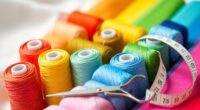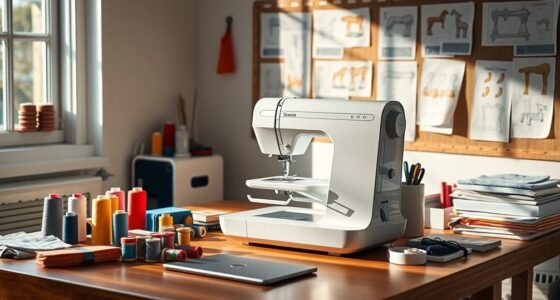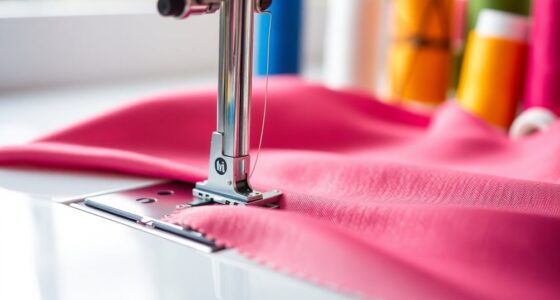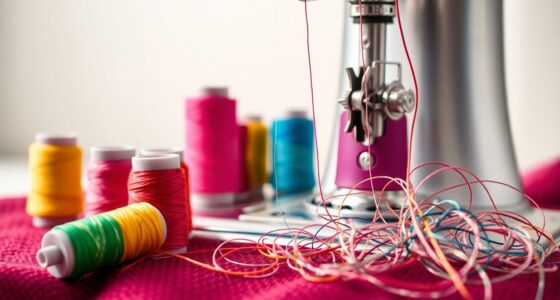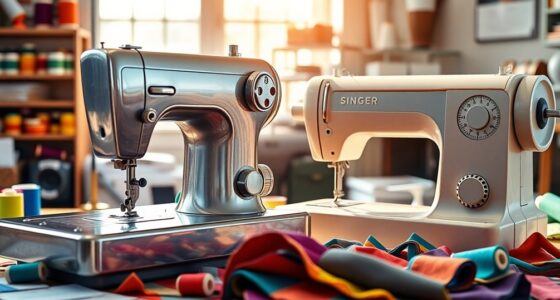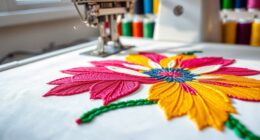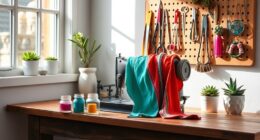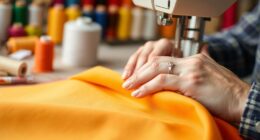A sewing machine works by coordinating its parts to stitch fabric together. The motor spins, causing the needle to move up and down while passing the upper thread through the fabric. The bobbin, holding the lower thread, intertwines with the needle thread to form secure stitches. Feed dogs push the fabric forward for even stitching. Adjusting the tension guarantees the thread's tightness is balanced for quality stitches. Stick around, and you'll uncover more about its fascinating mechanisms and care tips.
Key Takeaways
- A sewing machine operates by converting rotary motor motion into vertical needle movement for stitching fabric.
- The needle pulls the upper thread through the fabric, while the bobbin provides the lower thread to create interlocked stitches.
- Feed dogs grip the fabric and move it forward in measured increments, ensuring consistent stitch length.
- Tension discs regulate the upper thread tightness, preventing breakage and ensuring balanced, quality stitches.
- Different stitch types, like lock and zigzag stitches, are created by varying the needle and thread mechanisms for different sewing needs.
The Basics of Sewing Machine Operation

When you use a sewing machine, you'll find that it operates through a series of coordinated movements that allow you to create stitches efficiently.
The sewing machine works by using a motor that drives the needle mechanism, converting rotary motion into vertical movement. This lets the needle pierce the fabric and form a stitch.
The bobbin thread plays an essential role, working with the needle thread as the rotary hook captures the needle's thread loop to secure your stitches.
Meanwhile, the feed dog moves the fabric forward in sync, ensuring consistent stitch length.
To achieve balanced stitches, you'll also need to adjust the tension discs to keep the upper thread tight, preventing any breakage during your sewing projects.
Key Components of a Sewing Machine
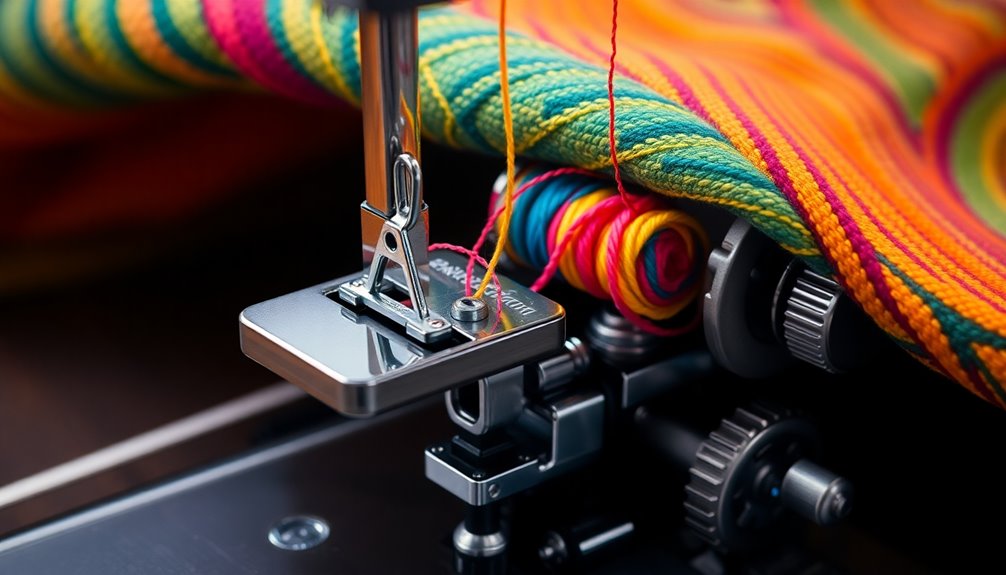
When you use a sewing machine, understanding its key components is essential for successful stitching.
Each part, from the needle to the feed dogs, plays an important role in how the machine operates.
Let's explore these fundamental mechanical parts and their functionalities to enhance your sewing experience.
Essential Mechanical Parts
Understanding how a sewing machine works begins with its essential mechanical parts, each playing a significant role in the stitching process.
The needle is critical, piercing the fabric to pull the upper thread through. Beneath the needle, the bobbin holds the lower thread, interlocking with the upper thread to form stitches.
As you sew, the feed dogs grip the fabric and move it forward, ensuring consistent stitch length. The presser foot keeps the fabric in place, allowing for smooth movement and precise stitching.
Finally, the tension discs control the tightness of the upper thread, which is fundamental for achieving balanced and high-quality stitches.
Together, these components work harmoniously to create beautiful seams in your projects.
Functionality of Key Components
While each component of a sewing machine serves a distinct purpose, their functionality is intricately connected to guarantee smooth operation.
The needle pierces the fabric, pulling the upper thread down to create stitches, while the bobbin holds the lower thread, working with the needle to form a secure lock stitch.
As you sew, the feed dogs grip and move the fabric, ensuring consistent stitch length.
The presser foot keeps the fabric in place, allowing for precise stitching and preventing movement during the process.
Finally, the tension discs control the tightness of the upper thread, which is vital for maintaining stitch quality and preventing problems like thread breakage or looping.
Understanding these components helps you achieve better sewing results.
Types of Sewing Machines

When you're choosing a sewing machine, you'll encounter several types tailored to different needs.
Mechanical machines are perfect for straightforward tasks, while computerized ones offer advanced features for intricate designs.
Additionally, specialized machines like sergers and embroidery machines can elevate your sewing projects with professional finishes and detailed patterns.
Mechanical Sewing Machines
Mechanical sewing machines are a popular choice for those looking to start their sewing journey, as they offer a straightforward and user-friendly experience.
These machines operate manually or with a foot pedal, using a direct mechanical drive to power the needle and fabric feed. They primarily employ a lock stitch mechanism, where the thread from the needle interlocks with the bobbin thread, creating strong, durable seams.
Basic mechanical models usually offer a limited number of stitch types, like straight and zigzag stitches, with manual adjustments for stitch length and width.
Designed for simplicity, they're often favored by beginners due to their ease of maintenance and lower risk of software issues compared to computerized machines.
Computerized Sewing Machines
Computerized sewing machines represent a significant advancement in the world of sewing, offering enhanced precision and a wealth of features that cater to both beginners and experienced sewists.
Equipped with built-in computers and monitor displays, these machines control multiple motors for precise movement, ensuring accuracy in every stitch. You can explore hundreds of stitch programs stored on removable memory disks or cartridges, giving you the freedom to customize your projects.
With USB connectivity, downloading patterns and designs from the Internet is a breeze, expanding your creative options. Advanced features like automatic thread cutters and programmable stitch sequences further streamline your sewing experience, making it easier than ever to achieve professional-quality results.
Specialized Sewing Machines
While many sewing machines cater for general needs, specialized sewing machines offer unique capabilities tailored for specific tasks.
These machines can elevate your sewing experience by streamlining processes and enhancing creativity.
- Sergers finish fabric edges and prevent fraying with overlock stitches.
- Embroidery machines create intricate designs, often programmable for artistic freedom.
- Industrial sewing machines handle thick fabrics, allowing production at high volumes.
You'll also find buttonhole machines that automatically craft buttonholes in various styles and sizes, making finishing touches effortless.
Ultimately, long-arm quilting machines are perfect for tackling large projects with ease.
Embracing these specialized sewing machines can truly transform your crafting journey!
Mechanisms Behind Stitch Formation

Understanding how a sewing machine forms stitches reveals the intricate coordination between its various components.
The process begins with the needle's upward and downward motion, piercing the fabric to create a loop of thread as it descends. This loop is then captured by the rotating shuttle mechanism, which interlocks it with the lower thread from the bobbin, forming a secure stitch.
Meanwhile, the feed dogs work in harmony with the needle and shuttle to advance the fabric in measured increments, ensuring consistent stitch length.
Tension discs play a critical role by regulating the tightness of the upper thread, which is essential for achieving even stitch quality and preventing breakage.
This seamless interaction makes sewing efficient and precise.
Understanding Stitch Types
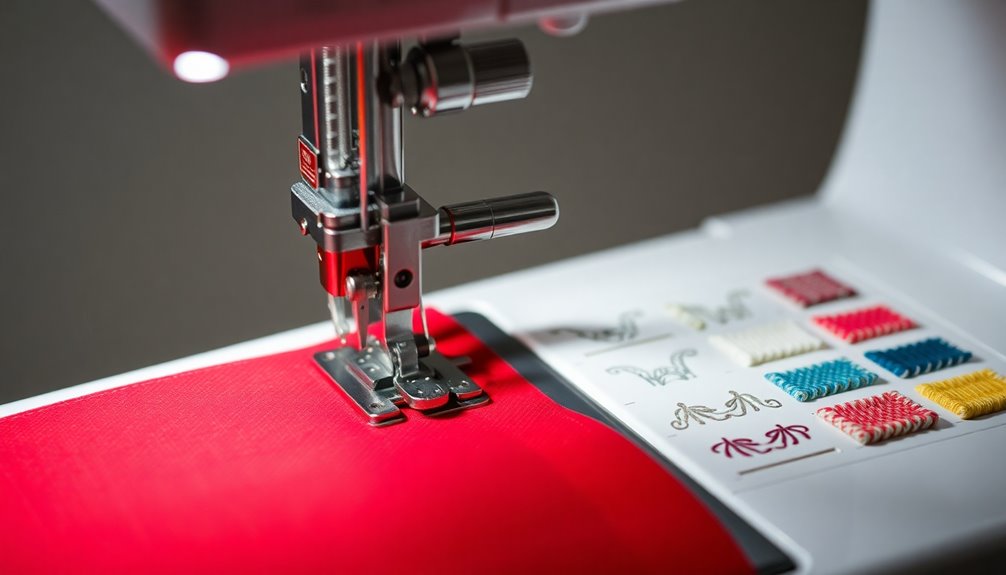
Stitch types play an essential role in your sewing projects, each serving specific purposes and offering unique characteristics. Understanding these stitches helps you choose the right one for your fabric and design.
- Lock stitch: Interlocks two threads for a secure, durable seam.
- Overlock stitches: Finish edges to prevent fraying, using multiple threads for strength and stretch.
- Decorative stitches: Add flair to your projects, allowing you to create intricate patterns with ease.
You'll find that the lock stitch is reliable, while chain stitches use a single thread and create machine loops, but they're less durable.
Zigzag stitches provide stretch, making them perfect for knit fabrics. Immerse yourself in the world of stitch types and elevate your sewing game!
Threading the Sewing Machine

Threading your sewing machine is an essential step that sets the foundation for successful sewing. Start by placing the upper thread spool on the spool pin, then pull the thread through the tension discs to guarantee proper tension.
Guide the thread through the thread take-up lever and down through the needle bar in preparation for threading the needle. For the lower thread, wind it onto a bobbin and insert it into the bobbin case, making certain it's correctly threaded to interact smoothly with the upper thread.
When threading the needle, bring the thread through the needle's eye from front to back. Finally, check the tension settings, as balanced upper and lower threads are critical for consistent, quality stitches.
Operating the Sewing Machine

Once you've threaded your sewing machine correctly, you're ready to start sewing.
First, verify the upper thread runs through the tension mechanism and the lower thread's securely in the bobbin case. Using the foot pedal, control the machine's speed for precise fabric handling and stitch formation.
Before you begin, adjust the stitch length and width to match your fabric type and desired style.
Gently guide the fabric under the presser foot, which keeps it steady while the needle creates those perfect stitches.
Don't forget to engage the reverse stitching feature at the start and end of seams to secure your stitches.
- Feel the excitement of creating something new
- Enjoy the satisfaction of mastering your machine
- Experience the joy of sewing with confidence
Maintenance and Care for Your Machine

Keeping your sewing machine in top shape is just as important as mastering its operation. Regular maintenance, like cleaning and oiling, prevents issues and extends your machine's lifespan. You should replace the needle frequently to avoid skipped stitches and snags. Also, check the tension often, as improper settings can lead to loose stitches or breakage. Finally, store your machine in a dust-free environment and cover it when not in use.
| Maintenance Task | Frequency |
|---|---|
| Cleaning | After each project |
| Oiling | Monthly |
| Needle Replacement | Every 8 hours of use |
| Tension Adjustment | Before each project |
| Dust Covering | Always when not in use |
Evolution of Sewing Machine Technology
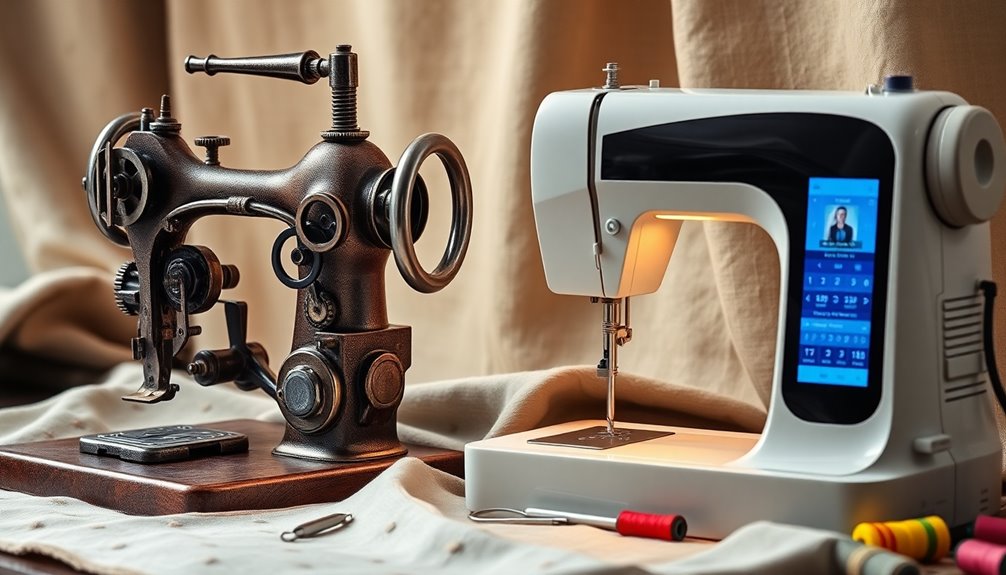
As sewing machines evolved over the years, they transformed from simple tools into sophisticated devices that redefine the art of stitching.
Starting with Barthélemy Thimonnier's 1829 creation for military uniforms, the journey continued with Elias Howe's 1846 patent of a two-thread machine.
Isaac Singer then revolutionized the industry in 1851 with his foot pedal design, making sewing machines more accessible.
Now, you can enjoy:
- Precision stitching that brings your creative visions to life.
- User-friendly interfaces that make sewing feel effortless.
- Innovative features like automatic thread cutters that save you time.
Today's machines boast advanced functionalities, such as computerized designs and connectivity options, showcasing a remarkable leap from their mechanical predecessors.
Frequently Asked Questions
How Does a Sewing Machine Work in Simple Terms?
When you think about how a sewing machine works, consider it as a clever tool that stitches fabric together.
You thread the machine, ensuring the upper and lower threads are in place. As you press the pedal, the needle moves up and down, creating loops that interlock the threads.
The feed dogs then move the fabric, allowing you to make even stitches. By adjusting settings, you can create various stitch types for your projects.
How Does a Single Thread Sewing Machine Work?
A single thread sewing machine works by using a lock stitch mechanism.
You'll insert the needle, which moves up and down, creating a loop of thread that the bobbin thread catches from below. As the needle descends, the rotary hook interlocks the threads, forming a secure stitch.
The feed dogs grip the fabric, moving it forward in sync with the needle, while tension discs adjust the upper thread's tightness for even stitches.
How Does a Sewing Machine Tie a Knot?
When you watch a sewing machine tie a knot, it's like witnessing magic in action!
As you guide the fabric, the needle descends and creates a loop with the upper thread. That's when the rotary hook swoops in, wrapping the needle thread around the bobbin thread to secure the loop.
As the needle rises, it forms a tight, consistent knot, thanks to the machine's tension settings.
You'll love how strong and durable each stitch feels!
What Is the Mechanism of a Sewing Machine?
The mechanism of a sewing machine combines several components working together seamlessly.
You'll notice the electric motor driving the needle, bobbin, and feed dogs. As you sew, the needle moves up and down, piercing the fabric while the bobbin rotates to catch the thread, creating stitches.
The feed dogs grip the fabric, moving it forward evenly. This coordination guarantees that you get consistent stitches and the versatility to tackle various sewing projects effortlessly. In addition to providing smooth fabric movement, the hidden function of feed dogs also ensures that the fabric is fed at the correct speed, allowing for precise control over the stitching process. This reliable mechanism minimizes the risk of uneven tension, which is crucial for achieving professional-quality results. Whether sewing delicate lace or sturdy denim, you can depend on this essential feature to enhance your sewing experience.
Conclusion
Now that you've unraveled the secrets of how a sewing machine works, you're ready to stitch your creativity into reality. Whether you're crafting a cozy quilt or mending a favorite shirt, remember that each turn of the wheel is a step toward turning your ideas into fabric art. So, thread your machine, embrace the rhythm, and let your imagination flow like a river, transforming simple threads into timeless creations. Happy sewing!

